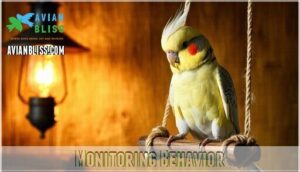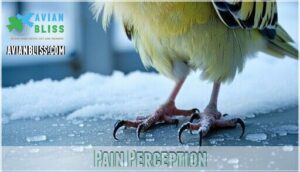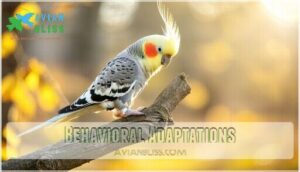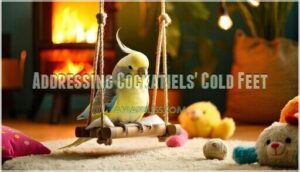This site is supported by our readers. We may earn a commission, at no cost to you, if you purchase through links.

Cold wire cage floors, drafty spots, or temperatures below 70°F can make their feet feel like tiny ice cubes. You’ll notice them tucking one foot up into their feathers or puffing up like a feathered balloon.
While occasional cold feet after baths or in cool rooms is fine, persistently cold feet could signal circulation problems or illness. Simple fixes like adding fleece bedding, thermal perches, or moving the cage away from windows can make a world of difference for your feathered friend’s comfort.
Table Of Contents
- Key Takeaways
- Why Cockatiels Get Cold Feet
- Detecting Coldness in Cockatiels
- Reasons for Parrots’ Cold Feet
- Sensitivity to Cold in Birds
- Addressing Cockatiels’ Cold Feet
- Frequently Asked Questions (FAQs)
- Why are cockatiels feet cold?
- How do I know if my cockatiel is cold?
- Why are my parrots’ feet cold?
- Can birds feel cold in their feet?
- Can cold feet in cockatiels indicate a vitamin deficiency?
- How often should I check my cockatiels feet temperature?
- Are certain cockatiel breeds more prone to cold feet?
- Do cold feet affect a cockatiels ability to perch?
- Can cockatiels get frostbite on their feet?
- How often should I check my cockatiels feet?
- Conclusion
Key Takeaways
- Cold feet are usually normal – Your cockatiel’s body naturally reduces blood flow to their feet when it’s chilly, prioritizing core temperature over extremities.
- Environmental factors matter most – Wire cage floors, drafts, and temperatures below 70°F cause cold feet, so you’ll want thermal perches, fleece bedding, and draft-free cage placement.
- Watch for concerning signs – While occasional cold feet after baths is fine, persistently cold feet with lethargy or appetite changes need a vet visit since they can signal circulation problems.
- Simple fixes work well – You can solve most cold feet issues by adding heated perches, moving the cage away from windows, and providing soft bedding materials for better insulation.
Why Cockatiels Get Cold Feet
Your cockatiel’s feet can get cold from several common causes that affect their natural temperature regulation.
Poor circulation, cold cage surfaces, and environmental factors like drafts or low room temperatures can all contribute to chilly feet in these sensitive birds.
Temperature Regulation
Understanding your cockatiel’s temperature regulation helps you tackle those cockatiel cold feet issues head-on. Your bird’s body maintains a steady 104-108°F through sophisticated thermoregulation mechanisms that control blood circulation to their feet.
Your cockatiel’s tiny feet work overtime maintaining that perfect 104-108°F body temperature through amazing natural heating systems
Here’s what’s happening inside your feathered friend:
- Counter-current heat exchange – Arteries and veins in their legs work together like a natural heating system
- Vasoconstriction response – Blood vessels narrow during cold exposure, reducing warmth to extremities
- Core temperature priority – Your bird’s body sacrifices foot warmth to protect essential organs
When temperatures drop below 70°F, your cockatiel’s circulation automatically shifts heat away from their feet. This survival mechanism can leave their little toes feeling chilly to your touch.
Heat lamps and proper cage insulation become essential tools for maintaining comfortable conditions. Good feather care also supports this natural temperature regulation system, helping your bird stay warm from head to toe. Using heat lamp products can be an effective way to provide a warm environment for your cockatiel.
Cage Flooring
Your cage flooring choices directly impact your cockatiel’s foot temperature. Wire or metal cage floors conduct cold rapidly, creating uncomfortable conditions that contribute to cockatiel cold feet. Instead, choose soft bedding materials like fleece or cage liners made from paper towels that provide thermal flooring benefits.
Insulated perches prevent heat loss better than bare metal ones. Size perches appropriately—too thin restricts circulation, too thick strains feet. Position your cage away from windows and vents for effective draft prevention.
Regular foot hygiene checks help you spot early cold feet causes before they become serious problems. Understanding proper wire cage floors is essential for maintaining a healthy environment.
Poor Blood Circulation
Several factors can disrupt your cockatiel’s blood flow, leaving their feet feeling like tiny ice cubes.
Cold feet can signal serious circulation problems that need immediate attention from your feathered friend’s vet
Poor circulation means those delicate extremities can’t maintain proper warmth, creating uncomfortable cold feet that signal deeper health concerns.
Three primary circulatory issues cause cold extremities in cockatiels:
- Cardiovascular disorders – Heart problems reduce blood flow to feet
- Dehydration – Insufficient fluids thicken blood and slow circulation
- Vascular health complications – Blocked or damaged blood vessels restrict flow
Watch for hypothermia symptoms like lethargy and fluffed feathers alongside cold feet.
These cockatiel cold symptoms indicate your bird’s body is struggling to maintain proper temperature regulation.
Don’t wait – treating cold feet requires professional evaluation.
An avian vet can assess cardio problems and identify underlying vascular issues causing poor blood circulation, ensuring your feathered friend stays warm and healthy.
Detecting Coldness in Cockatiels
You can spot if your cockatiel has cold feet by watching for specific behaviors and checking their physical condition.
Look for signs like shivering, puffed-up feathers, standing on one leg, or tucking their beak against their back—these are your bird’s natural ways of trying to stay warm.
Monitoring Behavior
Watch your cockatiel’s behavioral signs closely to spot cockatiel cold feet early.
Bird behavior changes when they’re chilly – you’ll notice one-leg perching, feather fluffing, and tucked beaks.
Activity levels drop substantially, while feeding habits may shift.
Regular monitoring behavior helps catch cold susceptibility before it worsens.
These behavioral adaptations signal your bird needs warmth fast.
Recognizing bird health problems is vital for providing appropriate care and preventing further complications.
Physical Examination
Hands-on foot inspection reveals your cockatiel’s circulatory health. Gently hold your bird and feel their feet—they should be warm and smooth to touch.
Cool or rough feet signal circulatory issues or potential illness. Check each toe assessment for swelling, discoloration, or splaying that restricts blood flow.
During your physical examination, observe leg examination for weakness or favoring one side. Don’t forget a quick beak check and feather condition assessment.
Proper bird foot care includes monitoring these signs regularly, as cockatiel cold feet often indicate underlying health concerns requiring veterinary attention.
Reasons for Parrots’ Cold Feet
You’ll find that your parrot’s cold feet aren’t just about chilly weather – they’re actually a clever survival mechanism.
Several factors can trigger this response, from natural heat conservation to environmental stressors that affect blood flow, which is a survival mechanism.
Physiological Adaptations
Your cockatiel’s circulatory system employs clever physiological adaptations for thermoregulation.
Countercurrent heat exchange in leg vessels transfers warmth from arterial blood to returning veins, maintaining core temperature while feet stay cooler.
This heat conservation mechanism reduces blood circulation to extremities during cold exposure through vasoconstriction.
Vascular health directly impacts this temperature regulation process, making feet feel cold as your bird’s body prioritizes keeping essential organs warm over peripheral comfort.
Understanding bird adaptations for survival is essential in recognizing the complex mechanisms that enable birds to thrive in various environments.
Environmental Factors
Beyond physiological factors, environmental conditions substantially affect your cold cockatiel’s comfort. Your bird’s cage placement and room temperature create the foundation for proper temperature regulation.
Key environmental factors to monitor:
- Draft prevention around windows and vents
- Maintaining climate control between 70-80°F
- Creating a draftfree zone away from air conditioning
- Using insulation methods like cage covers and soft bedding
A cold environment forces your cockatiel’s body to work harder maintaining warmth.
Sensitivity to Cold in Birds
Birds experience cold differently than mammals, and cockatiels are particularly sensitive since they’re native to Australia’s warm climate.
You’ll notice your cockatiel can feel pain from cold temperatures, which triggers specific behaviors like fluffing feathers, tucking one foot up, or shivering to generate warmth.
Pain Perception
Sensitivity to cold varies among cockatiels, and understanding pain perception helps you care better for your feathered friend.
Your bird’s feet contain specialized nerve tissue and blood vessels designed for perching on cold surfaces. However, pain receptors in their feet can still detect harmful cold stress.
When temperatures drop below 7°C, foot sensitivity increases dramatically, triggering pain signs like frequent lifting or shifting of feet.
While cockatiels have fewer pain receptors than mammals, extreme cold can cause nerve damage and circulation issues.
Maintaining proper thermal comfort prevents cold-induced pain and keeps your cockatiel healthy and comfortable.
Behavioral Adaptations
Birds naturally develop smart strategies to combat cold temperatures.
You’ll spot your cockatiel using Feather Puffing to trap warm air, creating insulation against chilly conditions.
Leg Tucking into belly feathers keeps feet warm, while Beak Shelter under wing feathers protects against heat loss.
Foot Shifting between legs prevents prolonged cold exposure, helping your bird manage circulatory issues effectively.
Understanding their cold weather adaptations is essential for providing the right care during winter months.
Addressing Cockatiels’ Cold Feet
Once you notice your cockatiel has cold feet, you’ll need to act quickly to warm them up and prevent health complications.
The key is creating a comfortable environment while monitoring for signs that might require veterinary attention.
Providing Warmth
Keeping your feathered friend cozy requires strategic warmth provision. Cage heating devices like ceramic heat lamps or thermal perches create comfortable spots without overheating risks.
Consider these warming essentials:
- Warm bedding materials like fleece provide natural insulation materials
- Panel heaters mounted near sleeping perches offer controllable comfort
- Draft-free placement protects against chilling winds
Temperature regulation improves when you combine heated perches with soft substrates, helping prevent cockatiel cold feet effectively. For ideal comfort, consider using a bird warmer solution to keep your cockatiel warm.
Ensuring Health and Well-being
While warmth matters, your cockatiel’s health comes first.
Watch for bird health symptoms like unusual lethargy or appetite changes. Regular health checks with an avian vet catch problems early.
Focus on proper nutrition advice – balanced diets support temperature regulation and circulation. Maintain good bird hygiene and foot care by keeping perches clean.
Consider thermal comfort through appropriate cage placement. Avian care isn’t just about cockatiel cold feet – it’s about total wellness.
Providing adequate bird heating solutions is essential for their overall well-being.
Frequently Asked Questions (FAQs)
Why are cockatiels feet cold?
Ever wonder why your feathered friend’s feet feel chilly?
Cold room temperatures, poor circulation, stress, illness, or exposure to drafts can cause your cockatiel’s feet to lose warmth, signaling environmental issues or health concerns.
How do I know if my cockatiel is cold?
Watch for shivering, puffed-up feathers, tucking their beak under wings, standing on one leg, lethargy, decreased appetite, and ruffled appearance. You’ll also notice cold feet when touching them.
Why are my parrots’ feet cold?
Cold feet, warm heart" rings true, but your parrot’s chilly toes signal temperature troubles.
Poor circulation, cold environments, stress, illness, or drafty cage placement commonly cause this.
Check room temperature, eliminate drafts, and provide warmer perches immediately to address the issue, considering the parrot’s cold feet as a signal for necessary action.
Can birds feel cold in their feet?
Yes, birds absolutely feel cold in their feet.
Their feet have nerve endings that detect temperature changes, making them sensitive to cold surfaces and environments.
When it’s chilly, you’ll notice your bird lifting one foot or tucking it up to possibly avoid the cold.
Can cold feet in cockatiels indicate a vitamin deficiency?
Nutritional shortfalls can subtly undermine your cockatiel’s circulation, potentially leading to chilly extremities.
While vitamin deficiencies aren’t the primary culprit behind cold feet, poor nutrition weakens blood flow and temperature regulation, making your feathered friend more vulnerable to poor nutrition.
How often should I check my cockatiels feet temperature?
You should check your cockatiel’s feet temperature daily during routine interactions.
A quick gentle touch while handling or during cage cleaning helps you notice changes early and catch potential health issues before they worsen, which is crucial for maintaining your cockatiel’s overall wellbeing.
Are certain cockatiel breeds more prone to cold feet?
Are certain breeds naturally better heat-retainers than others?
Actually, cockatiel cold feet isn’t breed-specific – it affects all cockatiels equally.
Environmental factors like temperature, cage setup, and health conditions matter more than genetics for keeping your bird’s feet warm.
Do cold feet affect a cockatiels ability to perch?
Cold feet can substantially impact your cockatiel’s perching ability.
When feet become cold, circulation decreases, reducing grip strength and coordination.
Your bird may struggle to maintain balance, shift weight frequently, or prefer standing on one foot to warm the other, which can be a clear sign of cold feet.
Can cockatiels get frostbite on their feet?
Yes, your cockatiel can get frostbite on its feet if exposed to very cold temperatures, especially near drafts or metal perches.
Keep the cage warm and cozy—think of it as a safe haven from winter’s bite.
How often should I check my cockatiels feet?
Like a car mechanic inspecting tires during routine maintenance, you’ll want to examine your cockatiel’s feet daily during regular interaction.
This quick visual check guarantees you’ll spot any swelling, discoloration, or temperature changes before they become serious health concerns, allowing for early detection of potential issues related to discoloration.
Conclusion
Understanding cockatiel cold feet is like reading a thermometer—it tells you about your bird’s environment and health.
When you notice your cockatiel’s feet feeling chilly, you’re witnessing their natural temperature regulation in action.
Most cases are easily fixed with warmer perches, better cage placement, or cozy bedding.
However, persistent cold feet warrant a vet visit.
By monitoring their behavior and making simple environmental adjustments, you’ll keep your feathered companion comfortable year-round.
- https://drcockatiel.com/cockatiels-illnesses/
- https://www.petsmopolitan.com/should-you-cover-your-birds-cage-at-night/
- https://www.askaveterinarianonline.com/bird-vet?r=ppc%7Cmslpa%7C17%7CPets%20-%20Bird%20Forum%20-%20All%20Device%20-%20Phrase%7CBird-Vet-Generic-Phrase%7C&JPKW=bird%20veternarian&JPDC=S&JPST=&JPAD=&JPMT=p&JPNW=o&JPAF=txt&JPRC=1&JPCD=&JPOP=&pmt=bp&cmpid=436399456&agid=1353500598821349&pcrid=84594207327278&fiid=&tgtid=kwd-84594874555262:loc-12&dvc=c&msclkid=cd46b8f48587103852b7db9dc44d3a9c
- https://medium.com/i-wanna-know/why-birds-dont-get-cold-feet-515487d50ed5
- https://www.bird-vet.com/









